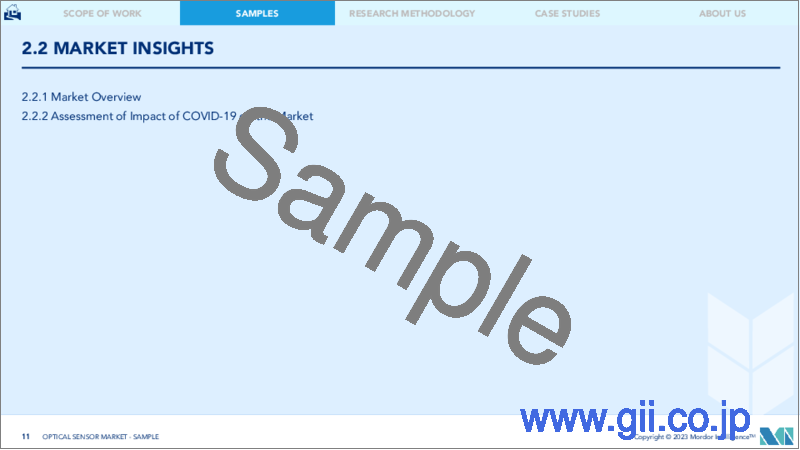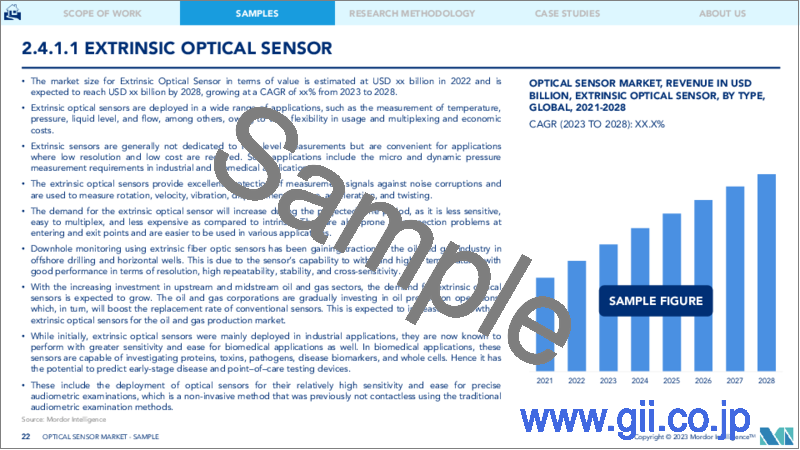|
|
市場調査レポート
商品コード
1197825
光学センサー市場- 成長、動向、予測(2023年-2028年)Optical Sensor Market - Growth, Trends, and Forecasts (2023 - 2028) |
||||||
|
● お客様のご希望に応じて、既存データの加工や未掲載情報(例:国別セグメント)の追加などの対応が可能です。 詳細はお問い合わせください。 |
|||||||
| 光学センサー市場- 成長、動向、予測(2023年-2028年) |
|
出版日: 2023年01月23日
発行: Mordor Intelligence
ページ情報: 英文 120 Pages
納期: 2~3営業日
|
- 全表示
- 概要
- 目次
光学センサー市場は、予測期間中にCAGR6.33%で成長すると予想されます。
主に、スマートフォンユーザーの増加と高度な技術が市場成長を牽引しているため。さらに、IoT接続されたデバイスは、産業、医療、家電、自動車などのいくつかのアプリケーションでセンサーの大規模な機会を開いた。シスコのAnnual Internet Reportによると、2023年までにネットワーク接続された家電や接続は、2018年の184億から約300億に増加するとされています。
主なハイライト
- スマートフォンの高度なセキュリティ機能に対する需要の高まりにより、画面上の指紋スキャンや指紋を検出・検証する光学センサーなどの機能が搭載され、光ファイバーセンサー市場を牽引しています。例えば、2022年5月にVivoは最新のフラッグシップスマホ「X80 Pro」を発表しましたが、その最も目立つ新ハードウェア機能は、ディスプレイ内の指紋センサーを大型化したことです。アクティブエリアは、ほとんどのAndroid携帯に搭載されている小さなセンサーよりもはるかに大きく、親指を合わせるために画面を見ることなく、簡単にロックを解除できることを意味します。
- さらに、アンビエントセンサーは、部屋の明るさを測定し、それに応じて画面の明るさを調整します。このように、スマートフォンの需要増は、これらのセンサーの需要を促進することが期待されます。インドのように、スマートフォンの普及率が低い国でも、近年は2桁の成長が続いています。この傾向はまもなく続くと予想されます。また、現在の4Gフィーチャーフォンの動向は、スマートフォンの需要を助け、光学センサーのニーズを促進すると予想されます。
- さらに、電気自動車の普及が進むことで、バッテリーの状態監視にプリンテッドエレクトロニクスが使用される機会も生まれています。例えば、IEAの推計によると、プラグイン電気自動車は最近、世界で670万台販売されました。さらにIEAは、2050年までのネット・ゼロ・エミッション・シナリオの一部として、3億台の電気自動車が普及し、新車販売の60%以上を占めると予測しています。
- また、これらの照明システムが商業施設や住宅に採用されることで、光学センサーの需要も増加すると予想されます。LEDとインテリジェント制御により、シカゴは2022年までの4年間で27万個の街灯を交換することを計画しました。この取り組みにより、シカゴでは年間1000万米ドルのエネルギーコストの削減が見込まれています。他の都市もこれに追随していることから、こうしたインテリジェント照明システムにおける光学センサーの需要は増加すると予想されます。
- 画質と価格のアンバランスから、特に民生用電子機器分野では競争が激化しており、一部の老舗企業は最適な価格設定をめぐって同業他社の圧力にさらされています。また、いくつかの小規模なプレーヤーは製品の差別化が困難であり、それが大量生産アプリケーションへの参入の潜在的な障壁に繋がっています。この場合、製品の差別化によって、製品を純粋な価格設定から非価格設定要因に移行させることができます。
- COVID-19の発生により、世界のサプライチェーンと複数のセンサーの需要は大きく混乱しました。中国などでの生産が停止したため、複数の業界で様々な製品の供給不足が観測されました。サプライチェーンの混乱により、原材料の価格が上昇し、近接センサーの全体的な価格設定に影響を与えました。
光学センサーの市場動向
光電センサが大幅な伸びを記録する見込み
- これらのセンサは、物体を検出する際の高い精度により、産業オートメーションマーケットでフルに使用されていることが認識されています。これらのセンサは、計数、監視、コンベア機構、輸送システム、工作機械、組立ラインなど、主に非接触の検出や測定用に、幅広い自動機械への統合が進んでいることがわかります。例えば、駐車支援システムにおいて、これらのセンサーは、後退する車両の通路にある物体の存在を検出し、促進要因に警告するためのアラームを発することができます。
- さらに、2022年8月、ロックウェル・オートメーションは、世界アプリケーション向けの光電センサを発表しました。最新のアレン・ブラドリー製光電センサ42EA RightSight S18と42JA VisiSight M20Aは、経済的で適用が容易なセンシングソリューションで、幅広いセンシングモード、取り付けオプション、独自の機能を備えており、世界オペレーションに最適なソリューションとなっています。すべてのサンプルには、位置合わせを容易にする可視赤色光源が搭載されており、複数の接続オプションと明暗操作用の調整ノブにより、設置、設定、メンテナンスの手間を省くことができます。
- また、製造業を促進する有利な政府政策とIIoTソリューションの採用の増加が、光電センサーの需要を促進する主な要因となっています。さらに、対前年比の自動車生産台数の増加や加工食品の需要の活況は、これらのセンサーの需要をさらに押し上げるでしょう。さらに、Philipsは最近、300カロールインドルピー(4041万米ドル)の投資と、インドで1500人の従業員を採用する計画を発表しました。同社は、インドでの製造を拡大するため、プネ事業を拡張する計画を発表しました。
- また、インダストリー4.0によるロボットやオートメーションの採用が進む中、精密な作業が急務となっています。そのため、光電センサーのニーズが高まっています。パッケージング、マテリアルハンドリング、自動車産業は、IIoTとビッグデータの連携や、スマートセンサーからのデータへの依存により、光電センサーの必要性を強調しています。
- IBEFによると、2022年4月、白物家電向けPLIスキームの二重申請で19社が申請し、1,548カロールインドルピー(1億9479万米ドル)の投資をコミットしました。さらに、PLIスキームの一環として、61社が14の州および都市部の111カ所に部品製造施設を設置し、インド全土で雇用を創出しています。このような製造業の発展は、市場の成長をさらに後押しするものと思われます。
アジア太平洋地域は大幅な市場成長を遂げるだろう
- 家電、産業、自動車、繊維などのエンドユーザー産業の急速な拡大は、光センサ市場の成長に大きく寄与しています。センサによって収集されたデータを照合してすぐに対応できるため、これらのセンサ自体が製造設備の生産性を向上させるために使用されます。IBEFによると、インドの家電・民生用電子機器産業は、最近98億4000万米ドルで、2025年には2倍以上の14億8000万インドルピー(211億8000万米ドル)に達すると予想されています。
- さらに、アジア太平洋地域における自動車の需要と生産の増加が、同市場におけるセンサーのニーズを促進すると予想されます。例えば、国際自動車工業会(OCIA)によると、インドの自動車(自動車と商用車を含む)総生産台数は30%に増加し、中国の自動車(自動車と商用車を含む)総生産台数は3%に増加しています。インドネシアの自動車(自動車、商用車を含む)総生産台数は63%に増加しました。こうした成長性を受けて、さまざまな企業がアジア太平洋に進出しています。
- 例えば、2022年8月、先端半導体ソリューションのトップサプライヤーであるルネサスエレクトロニクス株式会社は、インド・ベンガルールに拠点を置く4Dイメージングレーダーソリューションを提供するファブレス半導体企業であるSteradian Semiconductors Private Limitedの買収に合意しました。ルネサスは、ステラジアン社のレーダー技術を取得することで、レーダー市場でのプレゼンスを拡大し、産業用および自動車用センシングソリューションの提供を強化することができます。
- IBEFによると、インド政府は、自動車部門が2023年までに国内外から80~100億米ドルの投資を呼び込むと見込んでいます。さらに、2022年4月、Tata Motorsは、今後5年間で乗用車事業に24,000カロールインドルピー(30億8,000万米ドル)を投資する計画を発表しています。このような自動車分野への投資は、研究対象市場をさらに押し上げる可能性があります。
- さらに、スマートフォン市場における広範なセンサーの用途の増加が、同市場のセンサー需要を増加させると予想されます。例えば、2022年6月、ソニーグループは、製品ポートフォリオを拡大し、市場での地位を強化するために、イメージセンサー技術を強化する計画を発表しました。同社は、スマートフォンによる撮影時に複数のターゲットに焦点を合わせるためのソリューションを顧客に提供するために、研究開発能力に投資しています。市場における各社のこうしたインフィニティブは、スマートフォンにおけるセンサーの需要を高め、アジア太平洋地域におけるセンサーの需要成長を促進すると期待されます。
光学センサー市場の競合他社分析
世界の光学センサー市場は、競争が激しく、複数の大手企業で構成されています。これらの企業は、海外における顧客基盤の拡大に注力しています。これらの企業は、市場シェアと収益性を高めるために戦略的な協力の試みを活用しています。また、同市場で事業を展開する企業は、製品品質を強化するためにスマートオフィス技術に取り組む新興国を開拓しています。
- 2022年9月- 高度なデジタル画像処理、アナログ、タッチ&ディスプレイ技術などの半導体ソリューションの世界的大手開発企業であるオムニビジョンは、業界で唯一、ピクセルサイズ0.7ミクロンの920万画素(MP)CMOSイメージセンサーであるOV08Xを発表、1/5.7インチ光学フォーマットで4K解像度を可能にしました。OV08Xは、アスペクト比16:10(1920x1200)のモニターを搭載した最も厳しいY寸法4mmのモジュールノートPCで使用することができます。4セルのカラーフィルター配列とオンチップハードウェアリモザイクを組み合わせたノートパソコン市場向けの最初のイメージセンサーで、高品質な9.2MPベイヤー出力をリアルタイムで提供します。このセンサーは、低消費電力の画像信号プロセッサで作成され、最先端の光センシングと超低消費電力でバッテリーのスタミナを最大化することを提供します。
- 2022年2月- 世界なAIソフトウェア企業であり、仮想スマートセンサーのリーダーの一人であるElliptic Labsは、同社のAI仮想近接センサーINNER BEAUTYがXiaomiのRedmi K50 Gamingスマートフォンで出荷されると発表しました。Elliptic LabsのAIバーチャル近接センサーは、専用のハードウェアセンサーを必要とせず、堅牢な近接検知を実現します。AIバーチャル近接センサーは、ハードウェアをソフトウェアセンサーに置き換えることで、デバイスコストを削減し、ソーシングのリスクを排除します。
その他の特典
- エクセル形式の市場予測(ME)シート
- アナリストによる3ヶ月間のサポート
目次
第1章 イントロダクション
- 調査の前提条件と市場の定義
- 調査対象範囲
第2章 調査手法
第3章 エグゼクティブサマリー
第4章 マーケットインサイト
- 市場概要
- 産業の魅力- ポーターズファイブフォース分析
- 供給企業の交渉力
- 買い手の交渉力
- 新規参入業者の脅威
- 代替品の脅威
- 競争企業間の敵対関係
- 産業バリューチェーン分析
- COVID-19が市場に与える影響評価
第5章 市場力学
- 市場促進要因
- スマートフォンの普及率上昇
- 産業界における省電力デバイスの需要増加
- 様々な産業における自動化技術の市場浸透の増加
- 市場の課題
- 画質と価格のアンバランス
第6章 市場セグメンテーション
- タイプ別
- 外付け光学センサー
- 真性光学センサー
- センサータイプ別
- 光ファイバーセンサー
- イメージセンサ
- 光電センサー
- 環境光・近接センサ
- アプリケーション別
- 産業用
- 医療用
- バイオメトリクス
- 車載用
- 民生用電子機器
- 地域別情報
- 北米
- 米国
- カナダ
- 欧州
- ドイツ
- 英国
- フランス
- その他の欧州
- アジア太平洋地域
- 中国
- 日本
- インド
- その他アジア太平洋地域
- ラテンアメリカ
- ブラジル
- メキシコ
- その他のラテンアメリカ地域
- 中東・アフリカ地域
- アラブ首長国連邦
- サウジアラビア
- その他の中東・アフリカ地域
- 北米
第7章 競合情勢
- 企業プロファイル
- ROHM Co. Ltd
- Rockwell Automation Inc.
- SICK AG
- Vishay Intertechnology Inc.
- Honeywell International Inc.
- On Semiconductor Corporation
- IFM Efector Inc.
- Keyence Corporation
- Pepperl+Fuchs GmbH
- ROHM Co. Ltd
- STMicroelectronics NV
第8章 投資分析
第9章 市場の将来性
The optical sensors market is expected to grow at a CAGR of 6.33% over the forecast period. Primarily due to the increasing number of smartphone users and advanced technologies driving the market growth. Furthermore, IoT-connected devices have opened massive opportunities for sensors in several applications like industrial, medical, consumer electronics, automotive, etc. According to Cisco's Annual Internet Report, by 2023, there will be nearly 30 billion network-connected appliances and connections, up from 18.4 billion in 2018.
Key Highlights
- Increasing demand for advanced security features in smartphones has led to features such as an on-screen fingerprint scan and an optical sensor that detects and verifies fingerprints, driving the fiber optic sensor market. For instance, in May 2022, Vivo announced its latest flagship phone, the X80 Pro, and its most prominent new hardware feature is a larger in-display fingerprint sensor. The active area is far more significant than the tiny sensors found on most Android phones, meaning it's easier to unlock the phone without looking at the screen to align your thumb.
- Further, Ambient sensors measure the room's light and adjust the screen's brightness accordingly. Thus, the increasing demand for smartphones is expected to drive the demand for these sensors. Countries like India, with a limited market penetration of smartphones, have witnessed double-digit growth in recent years. The same trend is anticipated to continue shortly. Also, the current trend of 4G feature phones is expected to aid the smartphone demand, driving the need for optical sensors.
- Furthermore, the increasing adoption of electric vehicles creates opportunities for printed electronics to be used in battery condition monitoring. For instance, according to the IEA estimates, plug-in electric light vehicle worldwide sales amounted to 6.7 million units recently. Further, the IEA projects that, as a part of the Net Zero Emissions by 2050 Scenario, 300 million electric cars would be on the road and account for over 60% of new car sales.
- Also, the adoption of these lighting systems in commercial and residential applications is expected to increase the demand for optical sensors. With LEDs and intelligent controls, Chicago planned to replace 270,000 city lights over the next four years till 2022. This initiative is expected to save Chicago USD 10 million in energy costs annually. With other cities following suit, the demand for optical sensors in these intelligent light systems is expected to increase.
- The imbalance between image quality and price has led to increased competition, particularly for the consumer electronics segment, which has some of the most established players facing peer pressure over optimal pricing. Several small players are also facing difficulty with product differentiation, which leads to a potential barrier to their entry into high-volume applications. In this case, product differentiation can move a product from pure pricing to non-pricing factors.
- Due to the outbreak of COVID-19, the global supply chain and demand for multiple sensors were majorly disrupted. With the shutdown in production in countries such as China, multiple industries observed a supply shortage of various products. Due to supply chain disruption, the raw material price increased, impacting the overall pricing of the proximity sensor.
Optical Sensor Market Trends
Photoelectric Sensor is Expected to Register a Significant Growth
- These sensors have been recognized for their full use in the industrial automation marketplace, owing to their high precision in detecting objects. These sensors have found a rising integration into a wide range of automated machinery, mainly for non-contact detections and measurements, including counting, monitoring, conveyor mechanisms, transport systems, machine tools, and assembly lines. For instance, in the parking assistance system, these sensors can detect the presence of objects in the pathway of the reversing vehicle and can raise the alarm to warn the driver.
- Furthermore, in August 2022, Rockwell Automation announced Photoelectric Sensors for global applications. The latest Allen-Bradley 42EA RightSight S18 and 42JA VisiSight M20A photoelectric sensors are economical and easy-to-apply sensing solutions that deliver a wide range of sensing modes, mounting options, and unique features, making them optimal solutions for global operations. All samples have a visible red-light source to ease alignment, while multiple connection options and adjustment knobs for light or dark operation help reduce installation, setup, and maintenance.
- In addition, favorable government policies promoting the manufacturing industry, coupled with the rising adoption of IIoT solutions, are the major factors driving the demand for photoelectric sensors. In addition, growing year-on-year automotive production and booming demand for processed food will further boost the demand for these sensors. Additionally, Philips recently announced an investment of INR 300 crores (USD 40.41 million) and planned to recruit 1,500 employees in India. The company announced plans to expand its Pune operations to increase manufacturing in India.
- Moreover, with a greater inclination toward employing robotics and automation through Industry 4.0, there is a pressing need for precision in operations. Thus, driving the need for photoelectric sensors. The packaging, material handling, and automotive industries have emphasized the need for photoelectric sensors, owing to their collaboration of IIoT with Big Data and the reliance on data from smart sensors.
- According to IBEF, in April 2022, 19 companies filed applications for the PLI Scheme for White Goods in the dual round of applications, with committed investments of INR 1,548 crore (USD 194.79 million). Further, as a part of the PLI scheme, 61 companies have installed component manufacturing facilities in 111 locations throughout 14 states and UTs, creating jobs across India. Such developments in the manufacturing industry will further drive market growth.
Asia Pacific to Experience Significant Market Growth
- Rapid Expansion of the end-user industries, like consumer electronics, industrial, automobile, and textile, are contributing significantly to the growth of the optical sensors market as these sensors themselves are used to improve the productivity of manufacturing set-ups as the data gathered by the sensors can be collated and acted upon immediately. According to IBEF, the Indian appliances and consumer electronics industry stood at USD 9.84 billion recently and is expected to more than double to reach INR 1.48 lakh crore (USD 21.18 billion) by 2025.
- Furthermore, the increase in the demand and production of automobiles in the Asia-Pacific region is expected to promote the need for sensors in the market. For instance, as per the International Organization of Motor Vehicle Manufacturers (OCIA), the total production of automotive (including cars and commercial vehicles) in India increased to 30%, and the entire production of automotive (including cars and commercial vehicles) in China increased to 3%. Indonesia's total automotive output (including cars and commercial vehicles) increased to 63%. Various companies have expanded their presence in Asia-Pacific in response to such growth potential.
- For instance, in August 2022, Renesas Electronics Corporation, a premier supplier of advanced semiconductor solutions, agreed to acquire Steradian Semiconductors Private Limited, a fabless semiconductor company that provides 4D imaging radar solutions based in Bengaluru, India. The acquisition of Steradian's radar technology would enable Renesas to extend its market presence in the radar market and boost its industrial and automotive sensing solution offerings.
- According to IBEF, the Government of India expects the automobile sector to attract USD 8-10 billion in local and foreign investments by 2023. Furthermore, in April 2022, Tata Motors announced plans to invest INR 24,000 crore (USD 3.08 billion) in its passenger vehicle business over the next five years. Such investments in the automotive sector may further drive the studied market.
- Furthermore, the increasing applications of a wide range of sensors in the smartphone market are expected to increase the demand for sensors in the market. For instance, in June 2022, Sony Group announced its plan to enhance its image sensor technology to expand its product portfolio and strengthen its market position. The company has been investing in its R&D capabilities to provide its customers with a solution for focusing on multiple targets when taking a picture via a smartphone. Such infinitives by the companies in the market are expected to increase the demand for sensors in the smartphone, thereby fueling the demand growth for sensors in the Asia-Pacific region.
Optical Sensor Market Competitor Analysis
The global optical sensors market is highly competitive and consists of several major players. The players focus on expanding their customer bases across foreign countries. These companies leverage strategic cooperative endeavors to boost their market shares and profitability. The companies operating in the market are also developing startups working on smart office technologies to strengthen their product quality.
- September 2022 - OmniVision, a leading global developer of semiconductor solutions, including advanced digital imaging, analog, and touch & display technology, announced the OV08X, the industry's only 9.2 megapixels (MP) CMOS image sensor with a pixel size of 0.7-micron, enabling 4K resolution in a 1/5.7-inch optical format. The OV08X can be used in the most stringent 4mm y-dimension module laptops with 16:10 (1920x1200) aspect ratio monitors. It is the first image sensor for the laptop market to combine a four-cell color filter array and on-chip hardware remosaic, delivering high-quality, 9.2 MP Bayer output in real-time. The sensor is created with a low-power image signal processor to offer leading-edge light sensing and ultra-low power to maximize battery stamina.
- February 2022 - Elliptic Labs, a global AI software company and one of the leaders in Virtual Smart Sensors, announced that it's AI Virtual Proximity Sensor INNER BEAUTY would be shipping on Xiaomi's Redmi K50 Gaming smartphone. Elliptic Labs' AI Virtual Proximity Sensor delivers robust proximity detection without needing a dedicated hardware sensor. The AI Virtual Proximity Sensor reduces device cost and eliminates sourcing risk by replacing hardware with software sensors.
Additional Benefits:
- The market estimate (ME) sheet in Excel format
- 3 months of analyst support
TABLE OF CONTENTS
1 INTRODUCTION
- 1.1 Study Assumptions and Market Definition
- 1.2 Scope of the Study
2 RESEARCH METHODOLOGY
3 EXECUTIVE SUMMARY
4 MARKET INSIGHTS
- 4.1 Market Overview
- 4.2 Industry Attractiveness - Porters Five Forces Analysis
- 4.2.1 Bargaining Power of Suppliers
- 4.2.2 Bargaining Power of Buyers
- 4.2.3 Threat of New Entrants
- 4.2.4 Threat of Substitutes
- 4.2.5 Intensity of Competitive Rivalry
- 4.3 Industry Value Chain Analysis
- 4.4 Assessment of Impact of COVID-19 on the Market
5 MARKET DYNAMICS
- 5.1 Market Drivers
- 5.1.1 Increasing Market Penetration of Smartphones
- 5.1.2 Increasing Demand for Power-saving Devices Across Industries
- 5.1.3 Increasing Market Penetration of Automation Techniques Across Various Industries
- 5.2 Market Challenges
- 5.2.1 Imbalance Between the Image Quality and Price
6 MARKET SEGMENTATION
- 6.1 By Type
- 6.1.1 Extrinsic Optical Sensor
- 6.1.2 Intrinsic Optical Sensor
- 6.2 By Sensor Type
- 6.2.1 Fiber Optic Sensor
- 6.2.2 Image Sensor
- 6.2.3 Photoelectric Sensor
- 6.2.4 Ambient Light and Proximity Sensor
- 6.3 By Application
- 6.3.1 Industrial
- 6.3.2 Medical
- 6.3.3 Biometric
- 6.3.4 Automotive
- 6.3.5 Consumer Electronics
- 6.4 By Geography
- 6.4.1 North America
- 6.4.1.1 United States
- 6.4.1.2 Canada
- 6.4.2 Europe
- 6.4.2.1 Germany
- 6.4.2.2 United Kingdom
- 6.4.2.3 France
- 6.4.2.4 Rest of the Europe
- 6.4.3 Asia Pacific
- 6.4.3.1 China
- 6.4.3.2 Japan
- 6.4.3.3 India
- 6.4.3.4 Rest of the Asia Pacific
- 6.4.4 Latin America
- 6.4.4.1 Brazil
- 6.4.4.2 Mexico
- 6.4.4.3 Rest of the Latin America
- 6.4.5 Middle East & Africa
- 6.4.5.1 United Arab Emirates
- 6.4.5.2 Saudi Arabia
- 6.4.5.3 Rest of the Middle East & Africa
- 6.4.1 North America
7 COMPETITIVE LANDSCAPE
- 7.1 Company Profiles
- 7.1.1 ROHM Co. Ltd
- 7.1.2 Rockwell Automation Inc.
- 7.1.3 SICK AG
- 7.1.4 Vishay Intertechnology Inc.
- 7.1.5 Honeywell International Inc.
- 7.1.6 On Semiconductor Corporation
- 7.1.7 IFM Efector Inc.
- 7.1.8 Keyence Corporation
- 7.1.9 Pepperl+Fuchs GmbH
- 7.1.10 ROHM Co. Ltd
- 7.1.11 STMicroelectronics NV




